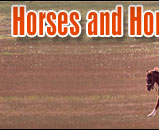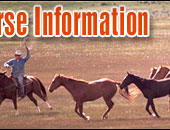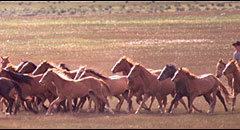 |
   |
|
|
|
You are here: Horses > Horse care > Up against the wall |
Helping Your Horse Regain Their Footing
If you see your horse cast in a stall the likely reaction is to panic. However,
doing this will only cause your horse to become frantic along with you which
increase their risk of injury.
|
|
|
Getting cast in a stall isnít something that happens everyday, but it may
happen sometimes. A horse may lie down too close to a wall or they may roll in
such a way that they end up in a position where they canít get their legs under
them to stand up again.
In cases of colic a horse may get cast more easily. In these cases a horse may
not watch where they are going since they just want to lie down and roll in
order to get rid of the pain so it often ends up in such a position. A horse may
just end up at a disadvantage if they are itchy and |
rolling. A horse will typically roll in the middle of the stall and nothing will
happen but there are always the exceptions.
 Pulling the horses head away
from the wall with the halter will generally allow them to free their feet
enough to get them back under themselves. If you must, you can pull the tail to
help drag the hind feet away from the wall. If the animal is thrashing and you
canít get to the tail easily then you may be able to use a lead shank for
assistance. Dropping the lead shank onto the ground should help the horse get to
their feet or at least allow you to grab the other end and pull outward. Pulling the horses head away
from the wall with the halter will generally allow them to free their feet
enough to get them back under themselves. If you must, you can pull the tail to
help drag the hind feet away from the wall. If the animal is thrashing and you
canít get to the tail easily then you may be able to use a lead shank for
assistance. Dropping the lead shank onto the ground should help the horse get to
their feet or at least allow you to grab the other end and pull outward.
There may be situations where a horse is so tight that their backs are against
the wall literally. A calm horse is easy in these situations since all you have
to do is grab the leg that is closest to the wall and roll the horse over to
help them regain their footing. Although looping a shank over the leg to
accomplish the same thing can be done if you have a horse that isnít calm.
You may have to go up in the hayloft and down the hay drop if your horse is cast
against the door with prevents you from opening it. A horse will want to get up
immediately once they are free and they may act exuberantly by bucking and
kicking. Therefore you should make sure you are on the right side of the stall
for a quick exit after the horse is free. A colicky horse may not want to move
even after being freed so you may have to give them a few taps of encouragement
on their rear. Check for abrasions once the horse is on their feet and calm
again. To make sure the horse hasnít injured themselves you should walk them
around a bit.
 |
Read the next horse care article on Painless Weaning Practices for Foals and Mares. |
|
|
|
|
 |
|
|
|
|
|
Horse Education
|
|
|
|
|
Horse Information Topics
|
|
|
|
|
|
|
|
Horse Business Owners
|
| |
Advertise with Us
Have your horse products or services exposed to over 27,000 of our monthly visitors.
|
|
|
|
|
|